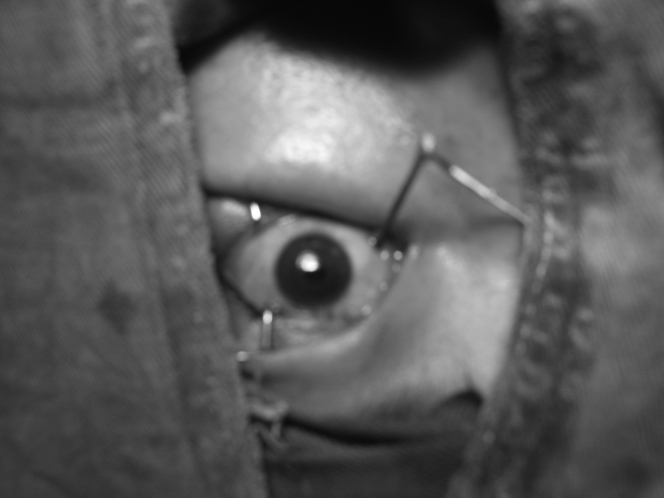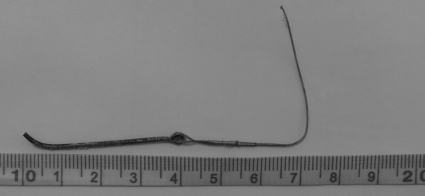Abstract
Vibrio alginolyticus is a facultative anaerobic gram-negative bacillus found in normal marine flora. Ocular infections induced by V. alginolyticus are extremely rare. We report a case of endophthalmitis caused by V. alginolyticus to draw attention to V. alginolyticus infections following ocular injuries.
CASE REPORT
A 26-year-old man was admitted to our department of ophthalmology after a fish hook bounced back and ripped into his left eye while fishing. The entrance of the scleral wound was at the 8:30 o'clock position 6 mm from the limbus. The fish hook had penetrated the sclera by about 3 cm outside the eyeball (Fig. 1). The best-corrected visual acuity (VA) was 20/20 in the right eye and 20/100 in the left. There were no signs of inflammation in the anterior chamber of the left eye. A fundus examination showed a grade I vitreous opacity in the left eye, and the preliminary diagnosis was a vitreous hemorrhage. Surgery was performed immediately to remove the fish hook (Fig. 2). The scleral wound was closed with 5-0 absorbable suture. Scleral buckling and cryopexy were performed to avoid a secondary retinal detachment. A computed tomography scan showed no radio-opaque intraocular foreign body after surgery. Considering that the contaminated fish hook penetrated the eye, 6.0 g of ampicillin was administered intravenously postoperatively to prevent infection and 10 mg dexamethasone to prevent further inflammation. At 8:00 a.m. on the first postoperative day, the VA of the affected eye was 20/150, and no inflammation developed in the anterior chamber. The patient did not report any discomfort. Tobramycin (0.3%) and 0.1% fluorometholone eye drops were instilled topically four times daily. Ampicillin and dexamethasone also were administered intravenously as previously described. Seven hours later on the first postoperative day, the patient complained of progressively blurred vision. The VA decreased to the level of hand movements, along with serious inflammation of the left eye and marked haze of the left vitreous. A fibrinous pupillary membrane formed in the anterior chamber without hypopyon. A diagnosis of posttraumatic endophthalmitis was made. The patient refused an intravitreal antibiotic injection. A 3-mm hypopyon developed within 30 min, and because the inflammation progressed quickly, pars plana lensectomy and vitrectomy were performed immediately. Intraoperatively, we found the lens was opaque and the vitreous cavity was filled with hemorrhages and veils. After cutting off the lens and most of the exudation, we found extensive full-thickness retinal necrosis, retinal vessel occlusion, and superficial hemorrhages. After clearing the vitreous cavity, we filled 12% of the vitreous cavity with perfluoropropane (C3F8) after air gas exchange. Three hours postoperatively, the patient was transferred to a tertiary hospital.
FIG. 1.
A fish hook penetrates the sclera by about 3 cm outside the eyeball.
FIG. 2.
The fish hook is removed from the eye.
Vitreous fluid was collected during vitrectomy and plated onto blood agar. Smooth, convex, creamy colonies became evident within 24 h. On a Gram stain, the isolate was gram negative. The isolate was identified as Vibrio alginolyticus by using the Vitek II automated system (bioMérieux, Marcy l'Etoile, France) with a 96% confidence level. Considering the high confidence level, no further identification was needed. Antimicrobial susceptibility determinations were performed automatically by the Vitek system, which generated the MICs shown in Table 1. The Kirby-Bauer agar diffusion method was used as a confirmatory tool. The Clinical and Laboratory Standards Institute (CLSI) guidelines for susceptibility testing of Vibrio species were followed.
TABLE 1.
Disk susceptibilities of the V. alginolyticus isolates
| Antibiotic | MIC (μg/ml) | Susceptibilitya |
|---|---|---|
| Ampicillin | ≤0.25 | S |
| Levofloxacin | ≤1 | S |
| Meropenem | ≤2 | S |
| Cefoxitin | ≤2 | S |
| Imipenem | ≤4 | S |
| Cefepime | ≤4 | S |
| Cefuroxime | ≤4 | S |
| Cefotaxime | ≤4 | S |
| Cefoperazone | ≤4 | S |
| Ceftazidime | ≤8 | S |
| Cefazolin | ≤8 | S |
| Piperacillin | ≤8 | S |
| Amikacin | 16 | S |
| Gentamicin | ≥16 | R |
R, resistant; S, susceptible.
After the patient was informed of the culture results, he did not return for 3 months. Although finally the infection had been controlled, his VA was at the level of no light perception in the left eye.
Discussion.
V. alginolyticus is a halophilic gram-negative bacterium. The bacterium can multiply in salt water at elevated temperatures. V. alginolyticus is one of 12 marine Vibrio species identified as pathogenic to humans. The bacterium is associated with wound infections (17, 20, 22, 23), ear infections (1, 4, 5, 6, 22), and gastrointestinal diseases (15). Although rare, deep-seated or invasive infections can develop. Cases of invasive V. alginolyticus infections, defined as bloodstream infection or deep-seated or necrotizing soft tissue infection (7, 8, 9), have been reported. The route of these infections is direct contact with contaminated seawater or ingestion of raw seafood, which is the same as that of other Vibrio infections.
Ocular infection due to V. alginolyticus is extremely rare. Vibrio species can cause conjunctivitis, keratitis, and endophthalmitis (3, 10, 14, 18, 19, 21, 24, 25). Endophthalmitis caused by Vibrio vulnificus (10, 21), Vibrio cholerae (25), and Vibrio parahaemolyticus (24) has been reported, but no cases of endophthalmitis resulting from V. alginolyticus. Conjunctivitis caused by V. alginolyticus also has been reported (14, 18, 19). Most reported cases had known exposure to shellfish, seawater, or septicemia. The current patient had an obvious eye trauma due to a fish hook.
Most patients with superficial V. alginolyticus infections have a benign course, with responses to only local therapy or no treatment. Cases of invasive V. alginolyticus infections can have a disastrous course. In the current case, we observed the development of rapidly blurred vision within a few hours. The eye was damaged despite immediate treatment. Early administration of antibiotics and surgical intervention, if needed, are critical to control these invasive Vibrio infections. If antibiotic therapy is administered, it should be based on the results of in vitro susceptibility testing. As reported, V. alginolyticus is resistant to the penicillins and vancomycin; variably sensitive to ampicillin, erythromycin, cephalothin (cefalotin), and colistin; and sensitive to ciprofloxacin, tetracycline, cefuroxime, chloramphenicol, trimethoprim-sulfamethoxazole, and gentamicin (7, 13, 22). In our test, the organism was susceptible to ampicillin, levofloxacin, meropenem, cefoxitin, imipenem, cefepime, cefuroxime, cefotaxime, cefoperazone, ceftazidime, cefazolin, piperacillin, and amikacin but resistant to gentamicin.
Penetrating ocular fish hook injuries are a rare yet potentially devastating ocular trauma. Eyelid injuries, corneal injuries, and retina injuries caused by fish hooks have been reported (2, 11, 12, 16, 26). Although most have good prognoses following prompt, appropriate surgical interventions, the patient in the current case had a poor prognosis. The infection and inflammation of our patient progressed too quickly to control.
V. alginolyticus is a facultative anaerobic gram-negative bacillus found in normal marine flora. To our knowledge, this is the first case of V. alginolyticus endophthalmitis induced by a fish hook reported in the literature. Endophthalmitis due to V. alginolyticus should be considered, especially when a fish hook injury is involved.
Acknowledgments
We have no relevant conflicts of interest.
Footnotes
Published ahead of print on 26 August 2009.
REFERENCES
- 1.Ardiç, N., and M. Ozyurt. 2004. Case report: otitis due to Vibrio alginolyticus. Mikrobiyol. Bul. 38:145-148. [PubMed] [Google Scholar]
- 2.Bartholomew, R. S., and M. Macdonald. 1980. Fish hook injuries of the eye. Br. J. Ophthalmol. 64:531-533. [DOI] [PMC free article] [PubMed] [Google Scholar]
- 3.Butt, A. A., J. Figueroa, and D. H. Martin. 1997. Ocular infection caused by three unusual marine organisms. Clin. Infect. Dis. 24:740. [DOI] [PubMed] [Google Scholar]
- 4.Dronda, F., R. Cantón, J. L. Selma, F. García-Ramos, and M. Martínez-Ferrer. 1991. Vibrio alginolyticus and swimmer's otitis externa: 2 cases and review of the literature. Enferm. Infect. Microbiol. Clin. 9:630-633. [PubMed] [Google Scholar]
- 5.Feingold, M. H., and M. L. Kumar. 2004. Otitis media associated with Vibrio alginolyticus in a child with pressure-equalizing tubes. Pediatr. Infect. Dis. J. 23:475-476. [DOI] [PubMed] [Google Scholar]
- 6.García-Martos, P., M. Benjumeda, and D. Delgado. 1993. Otitis externa caused by Vibrio alginolyticus: description of 4 cases. Acta Otorrinolaringol. Esp. 44:55-57. [PubMed] [Google Scholar]
- 7.Gomez, J. M., R. Fajardo, J. F. Patiño, and C. A. Arias. 2003. Necrotizing fasciitis due to Vibrio alginolyticus in an immunocompetent patient. J. Clin. Microbiol. 41:3427-3429. [DOI] [PMC free article] [PubMed] [Google Scholar]
- 8.Ho, P. L., W. M. Tang, K. S. Lo, and K. Y. Yuen. 1998. Necrotizing fasciitis due to Vibrio alginolyticus following an injury inflicted by a stingray. Scand. J. Infect. Dis. 30:192-193. [DOI] [PubMed] [Google Scholar]
- 9.Howard, R. J., M. E. Pessa, B. H. Brennaman, and R. Ramphal. 1985. Necrotizing soft-tissue infections caused by marine vibrios. Surgery 98:126-130. [PubMed] [Google Scholar]
- 10.Jung, S. I., D. H. Shin, K. H. Park, J. H. Shin, and M. S. Seo. 2005. Vibrio vulnificus endophthalmitis occurring after ingestion of raw seafood. J. Infect. 51:e281-e283. [DOI] [PubMed] [Google Scholar]
- 11.Kamath, G. 2000. Fish hook injury of the eyelid: an unusual case. Br. J. Ophthalmol. 84:441-442. [DOI] [PMC free article] [PubMed] [Google Scholar]
- 12.Knox, F. A., W. C. Chan, C. E. McAvoy, S. E. Johnston, and J. H. Bryars. 2004. Penetrating ocular injuries from fish-hooks. Int. Ophthalmol. 25:291-294. [DOI] [PubMed] [Google Scholar]
- 13.Lee, D. Y., S. Y. Moon, S. O. Lee, H. Y. Yang, H. J. Lee, and M. S. Lee. 2008. Septic shock due to Vibrio alginolyticus in a cirrhotic patient: the first case in Korea. Yonsei Med. J. 49:329-332. [DOI] [PMC free article] [PubMed] [Google Scholar]
- 14.Lessner, A. M., R. M. Webb, and B. Rabin. 1985. Vibrio alginolyticus conjunctivitis. First reported case. Arch. Ophthalmol. 103:229-230. [DOI] [PubMed] [Google Scholar]
- 15.Libinzon, A. E., G. D. Lebedev, I. V. Pavlova, A. F. Nagornaia, and N. V. Krasnova. 1975. Isolation of parahemolytic vibrions from persons with acute gastrointestinal diseases. Zh. Mikrobiol. Epidemiol. Immunobiol. 9:25-29. [PubMed] [Google Scholar]
- 16.Mandelcorn, M. S., and A. Crichton. 1989. Fish hook removal from vitreous and retina. Case report. Arch. Ophthalmol. 107:493. [PubMed] [Google Scholar]
- 17.Matsiota-Bernard, P., and C. Nauciel. 1993. Vibrio alginolyticus wound infection after exposure to sea water in an air crash. Eur. J. Clin. Microbiol. Infect. Dis. 12:474-475. [DOI] [PubMed] [Google Scholar]
- 18.Penland, R. L., M. Boniuk, and K. R. Wilhelmus. 2000. Vibrio ocular infections on the U.S. Gulf Coast. Cornea 19:26-29. [DOI] [PubMed] [Google Scholar]
- 19.Ratnam, S., and M. Watson. 1985. Vibrio alginolyticus conjunctivitis. Arch. Ophthalmol. 103:1283-1284. [DOI] [PubMed] [Google Scholar]
- 20.Rubin, S. J., and R. C. Tilton. 1975. Isolation of Vibrio alginolyticus from wound infections. J. Clin. Microbiol. 2:556-558. [DOI] [PMC free article] [PubMed] [Google Scholar]
- 21.Sato, T., Y. Inatomi, T. Yonehara, S. Fujioka, Y. Hashimoto, T. Hirano, and M. Uchino. 2005. A patient with Vibrio vulnificus meningoencephalitis. Rinsho Shinkeigaku 45:18-21. [PubMed] [Google Scholar]
- 22.Schmidt, U., H. Chmel, and C. Cobbs. 1979. Vibrio alginolyticus infections in humans. J. Clin. Microbiol. 10:666-668. [DOI] [PMC free article] [PubMed] [Google Scholar]
- 23.Spark, R. P., M. L. Fried, C. Perry, and C. Watkins. 1979. Vibrio alginolyticus wound infection: case report and review. Ann. Clin. Lab. Sci. 9:133-138. [PubMed] [Google Scholar]
- 24.Steinkuller, P. G., M. T. Kelly, S. J. Sands, and J. C. Barber. 1980. Vibrio parahaemolyticus endophthalmitis. J. Pediatr. Ophthalmol. Strabismus 17:150-153. [DOI] [PubMed] [Google Scholar]
- 25.Yang, C. C., B. J. Lee, S. S. Yang, Y. H. Lin, and Y. L. Lee. 2008. A case of non-O1 and non-O139 Vibrio cholerae septicemia with endophthalmitis in a cirrhotic patient. Jpn. J. Infect. Dis. 61:475-476. [PubMed] [Google Scholar]
- 26.Yildirim, N., E. Kabadere, and Z. Ermis. 2008. Perforating corneal injury with a fish hook. Ophthalmic Surg. Lasers Imaging 39:137-139. [DOI] [PubMed] [Google Scholar]




